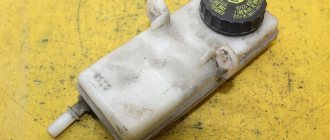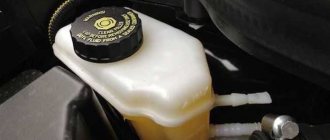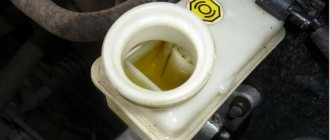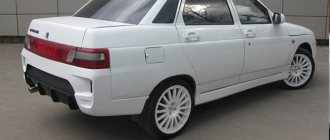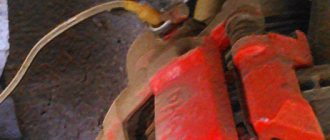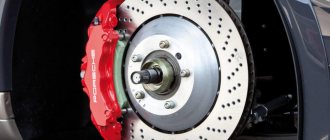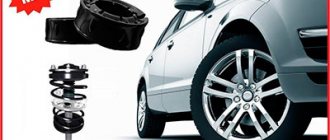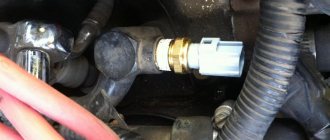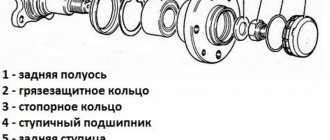05.08.2020
| (Votes: 1, Rating: 5) |
Issues discussed in the material:
- Reasons for replacing brake fluid
- Brake fluid change intervals
- Selecting brake fluid for replacement
- The most common way to change brake fluid
- Factory replacement of brake fluid
- Opinion of car enthusiasts on replacing brake fluid
Replacing brake fluid is a routine procedure that is necessary to maintain normal operation of the brake system. The condition of the brake fluid directly affects the quality of braking, and if it was replaced a long time ago or the brake fluid itself does not perform well enough, then you cannot drive such a car.
The replacement procedure itself is not complicated, but the most popular method requires two people. In our article we will talk about how you can change the fluid, as well as give replacement intervals and talk about the types of fuel fluid itself.
Reasons for replacing brake fluid
To keep your car in good condition, all fluids should be changed every 2-3 years. This is necessary because they lose their properties over time.
Why might you need to replace your brake fluid? First of all, because it absorbs moisture. As a result, the fuel fluid will boil during prolonged startup or when the hydraulic system is operating under stress. In addition, excess moisture can cause rust to form in the brake system.
When to perform a partial or complete brake fluid change:
- if it is recommended by the car manufacturer;
- if a breakdown occurs (hoses break);
- you have replaced the brake system or components;
- when water got inside the system;
- airing of the system occurred.
It doesn't matter what brand of brake fluid you use. As soon as the composition is inside the system, it will begin to absorb moisture. Why is this happening:
- the seals are badly worn;
- the sealing flaps also failed;
- the machine has not been used for a long time;
- forced or unintentional incorrect mixing of poured compounds;
- poor condition of the brake fluid tank.
It should be noted that even if the composition absorbs a little moisture, only 3-4%, the TJ will definitely boil. As a result, the brakes may fail and the cylinders will become blocked. Moreover, all this can happen when the car brakes sharply in an emergency. For this reason, brake fluid should be changed regularly, namely 2–4 times a year. When your car is old enough, this needs to be done even more often.
Saving on replacement parts can lead to irreparable consequences!
A complete replacement of the brake fluid may be required if the old compound was previously filled in or the fluids were mixed incorrectly. For example, many manufacturing companies produce TJ with unique additives, so using this composition with others is prohibited.
In fact, even a beginner can replace the TJ. However, many car owners entrust this work to specialists because they do not know the sequence of actions. The cost of this procedure in a car service is low. But every experienced driver should know how it is produced. Next, we will look at the basic steps that should be followed when changing brake fluid.
How to find it in Hyundai?
When using a Hyundai car, you need to periodically check the volume of brake fluid. If necessary, add fluid to the tank. The reservoir into which the brake fluid must be filled is located on the main cylinder, on the left side of the engine compartment.
In order to avoid the costs of repairing the brake system, or even the entire car, in the future, change the used working fluid with a new one in a timely manner . Brake fluid is highly hygroscopic (absorbs moisture from the air). This not only increases the corrosive effect on spare parts, but also reduces the boiling point of the liquid itself. This may cause the braking system to stop working. Do not re-apply the drill. It contains too much dirt, air and moisture.
We recommend: What does a car clutch consist of and how does it work?
Brake fluid change intervals
What affects the frequency of changing brake fluid:
- Car model. The vehicle operating instructions must indicate when (at what mileage in km) the TJ should be replaced.
- Composition of the liquid. If the fuel fluid is of high quality and of a new class, it will not need to be replaced so often.
- Features of the operation of the vehicle, how tight the brake system is, how a person drives the car: calmly or aggressively, driving in traffic jams.
The standard intervals for changing brake fluid are as follows:
- Every 24–36 months or after 50,000 km.
- When the vehicle has not been used for a long time, for example, more than 24 months.
- After repair work on the brake system: lines, pipes, pipes. This does not apply to pads and calipers if the brake system was not depressurized during repair work.
- If the fuel fluid is in poor condition, it is dirty or has been moistened by more than 3%.
To determine how much fluid the brake fluid has absorbed, special electrical devices are used. They determine the moisture content of the composition. The cost of such devices is quite high, and it is recommended to purchase them only if you yourself work in a car service and will use the device constantly.
Purpose of the container
The design of the domestic VAZ 2107 car uses a hydraulic braking system, consisting of drive and actuator mechanisms, as well as lines in the form of tubes and hoses, and a reservoir filled with liquid. This liquid substance acts as a drive source, and it is called brake fluid - an acid that is hygroscopic. It is poured into a transparent plastic container under the hood, but more on that.
The container in question on the seven is made of soft and impact-resistant plastic. It is almost impossible to break the tank, but it is easy to damage it with a sharp tool. The reservoir is filled with fluid, which goes to the master cylinder. The piston moves in the cylinder when the middle pedal is pressed, thereby increasing the pressure in the system. When the pressure increases, the working cylinders are activated, in which the pistons move under the action of a liquid substance.
From a brief description of the principle of operation of the brake system on the VAZ 2107, it is clear that the reservoir plays a fundamental role. It ensures an uninterrupted supply of working substance to the main cylinder of the system. If lines or operating mechanisms are damaged, the tightness of the system is compromised. Due to the fact that the tank has transparent walls, it is possible to identify system malfunctions easily and quickly. To do this, you need to open the hood and look to see if the container is full.
How to change the tank
Before replacing the brake fluid reservoir, you need to understand its location. The reservoir is located on the driver's side under the hood. When you open the hood, you need to look at the wall closest to the cabin, where there will be two plastic tanks next to each other. The first reservoir, which is located to the left, is a container for brake fluid. Next to this tank there is another tank of a smaller volume - this is a container for a similar substance, which is used in the clutch system.
Vehicle owners should be aware that brake fluid must be replaced every 40 thousand km. If the car has mileage above this indicator, then the quality of the mixture deteriorates, which can cause brake failure at any time. In addition to replacing the mixture every 40,000 km, it is also necessary to periodically monitor the level of brake fluid in the reservoir and, if necessary, top it up.
Selecting brake fluid for replacement
Even knowing the regulations for replacing brake fluid, many inexperienced car owners choose the wrong composition. What are the most common errors:
- Each composition has a DOT mark (United States Department of Transportation standard). Today on sale there are grades DOT 5.1 and 5, DOT 4 and DOT 3, differing in viscosity. The composition should be chosen taking into account what the car manufacturer recommends.
- It is impossible to pour ultra-modern brake fluids into cars of the twentieth century. The fact is that the rubber elements of the brake system are not compatible with the brake fluid, in addition, the fluid has an inappropriate composition.
- Also, you cannot mix TJ. As a result of this action, the brake system will work worse. As a result, the motorist will have to completely replace the composition.
Note!
TJ is toxic. If it gets on the skin, eyes or mucous membranes, a chemical burn will occur.
When changing the brake fluid, you should have a cloth ready to immediately wipe off the brake fluid if it gets on the plastic elements of the car or on the body. If the product gets on the surface of the machine, remove the contamination with water and wipe with a cloth.
How to choose the right composition? To do this, many nuances must be taken into account, except for the boiling point. For example, you need to know the following mixture parameters:
- TJ viscosity;
- ability to resist corrosion;
- the result of exposure to rubber parts;
- degree of stability;
- lubricity.
When choosing a composition, first of all, pay attention to how viscous the fuel fluid is. If it is thick, the brake system will fail in cold weather. If it is hot outside and the composition used is too liquid, a leak will occur.
The ability of the composition to resist corrosion is also one of the most important properties of the composition. For this, the manufacturer uses special additives. Inhibitors are substances that slow down corrosion. To determine how effective the additive is, the brake system elements are kept in liquid fluid moistened to 3.5% for 5 days at boiling temperature.
Compatible with rubber elements. If TJ has a negative effect on the rubber, it will swell or shrink on the cuff. If the rubber swells, the piston will destroy the seals. If shrinkage occurs, a leak may occur.
We recommend
“How often to change brake fluid and why to do it” More
In order for the brake fluid to perform its functions effectively, the composition must be stable at temperatures from -50 °C to +150 °C.
The lubrication characteristics of the fluid are determined during bench tests. This simulates the operation of the brake cylinders at maximum load.
The most common way to change brake fluid
Every car owner can replace brake fluid; the main thing is to approach this work responsibly. Manipulations must be carried out carefully, since you are using a chemically active composition. If TJ gets on the skin or eyes, a burn will occur. If this happens, you should rinse the affected area with water.
Important!
If engine oil gets into the brake system, it will fail.
To change the brake fluid you will need:
- free time 60 minutes;
- socket wrench 10;
- TZh in the volume recommended by the car manufacturer (with a reserve);
- rubber gloves to protect hands;
- textile;
- water;
- a basin or bucket where you will drain the used fuel oil;
- drip hose;
- a friend who will help you.
The sequence of actions is as follows:
- It is necessary to drive the car onto a viewing hole or overpass.
- Then you need to turn off the engine without squeezing the handbrake. It is necessary to jam the wheels with shoes, open the hood, unscrew the cover of the head brake cylinder (place it so as not to drop it or get dirty). The wires should be disconnected from the cover in advance.
- Next, you need to unscrew the mounting bolts from the wheel, jack up the car and remove the wheel.
- Using a cloth, you need to clean the area where the drain valve is located, if necessary, wet the surface and scrub with a brush.
- Then you need to remove the protective rubber cap from the valve.
- You need to put a hose (from the dropper) on the fitting, with its help you can find out how dirty the fuel fluid is.
- Now you can unscrew the valve using a 10mm spanner. Next, you need to put a hose on the valve and lower it into a bucket or basin.
- At this time, the second person should press the brake in the following order: 4 times as standard, on the fifth press, lock the pedal for a few seconds.
- You will notice that old fuel fluid will flow out through the hose. As soon as it stops flowing, you should quickly close the valve, otherwise the system will air out.
- These steps should be performed several times until the fuel fluid level in the tank is minimal. Then you need to add new composition to the upper level and continue pumping the system until clean fuel fluid comes out of the hose.
- After this, we begin replacing the brake fluid on the second wheel, you should move like this: rear left - front right. If you violate this principle, the replacement of the TJ will be performed incorrectly.
- When finished, check that the brake pedal moves smoothly and stops in the lower and upper positions. If this is not the case, it means that the brake system has become airy and a traffic jam has formed. In this case, you will have to re-pump all the circuits separately. Most often, air gets inside the system when the fuel fluid replacement technology is violated.
- After changing the brake fluid, it is important to make sure that the rubber caps are in place.
- Then you need to top up the fuel fluid to the maximum level.
- Next, close the master cylinder cover.
- Test the operation of the brake system. To do this you need to drive along the highway.
Theory:
For the brake mechanisms to function properly, the fluid must have a number of properties, which in our country are described by an interstate standard.
However, in practice it is customary to use the American quality standard FMVSS No. 116, which was developed by the United States Department of Transport. It was he who gave birth to the abbreviation DOT, which became a household name for brake fluid. This standard describes characteristics such as viscosity grade, boiling point, corrosion resistance, level of moisture absorption from the surrounding atmosphere, etc. One of the mandatory procedures when servicing a modern car is replacing operating fluids at certain mileages. Everyone understands perfectly why they need to change engine oil, but not everyone knows the reasons why the same is done, say, with antifreeze or brake fluid.
Meanwhile, it is banal - loss of performance:
When you press the brake pedal, air enters the compensation holes of the system and the brake fluid absorbs moisture from it. Although the hygroscopicity of brake fluid becomes a disadvantage over time, it is necessary. This property allows you to get rid of water droplets in the brake system. Once water gets into it, it can cause corrosion, and at sub-zero temperatures it can simply freeze, which at best will leave you without brakes in the winter, and at worst will lead to corrosion and expensive repairs. But the more water dissolves in brake fluid, the lower its boiling point and the greater its viscosity at low temperatures. It is enough to contain 3% water in the brake fluid so that its boiling point drops from 230°C to 150°C.
Factory replacement of brake fluid
In the factory, a specialist places a fitting on the neck of the reservoir, through which the system is filled with brake fluid under high pressure. The master, who stands below, must open the bleeder fittings on the cylinders one by one. Air will come out of them, and then the spent composition. After this, the fitting is tightened. As soon as this manipulation is performed on all wheels, new fluid will be added to the brake system.
Now the specialist disconnects the fitting from the tank neck, which is located on the master cylinder, and then tightens the tank cap.
What if the car owner independently replaces the brake fluid using this technology? In the case where you have repaired the brake system, replaced hydraulic elements, or bled the system because it was airy, you should use the “pump and hold” method.
If the fuel fluid passes through the tubes and cylinder cavities under high pressure, it will be possible to eliminate airing.
But what do you do when you need to change the brake fluid according to the car manufacturer's recommendations? On one car model this needs to be done every 24 months, on another after 36 months. In this case, it is best to flush the system with a new fuel fluid. Since the tank is located high, the spent composition flows down to the working cylinders. In such a situation, you can make the replacement yourself without the help of a second person.
How much brake fluid does it take to change?
It is recommended to buy at least 1 liter of TJ.
Interesting fact: the dimensions of a passenger car, its cross-country ability, or the use of a traction control system do not matter; in any case, the brake system holds no more than 0.5 liters of fuel fluid.
Please note that when replacing, the used composition and the new one are mixed, which means that a little more fuel fluid will be required. The best option is to buy 1 liter of any brand, since they can all be mixed.
Most motorists use DOT-4. Frequent replacement of such a composition is required due to the active absorption of moisture from the air. As a result of increased hygroscopicity, the composition loses its properties.
Thus, in order to replace the fuel fluid with your own hands, you should drive the car onto an overpass or inspection hole so that you can easily get to the area from where you will pour fuel fluid into the tank in the engine compartment, as well as to the brake cylinders of the car’s wheels.
First you need to remove the used compound from the tank using a rubber bulb. Then fill in new fuel fluid to the required level. To drain the mixture from all cylinders at once, you should prepare 4 tubes that fit tightly onto the cylinder bleeder fittings. The ends of the tubes should be placed in bottles.
We recommend
“Checking the brake fluid: a guarantee of safety on the roads” Read more
Then you should unscrew the brake cylinder fittings and make sure that the mixture flows out through all 4 pipes. It is important to monitor how much fluid is left in the tank on the brake cylinder and add new fluid in a timely manner. Pay attention to how much of the used compound has leaked into the bottles that are located near the brake cylinders.
You will have to leave 3-4 times to watch the mixture drain from the brake cylinder fittings in order to add fuel fluid into the tank on the brake cylinder. This is the only way to prevent it from drying out.
The fastest way to fill is a bottle into which the compound flows from a hose from the brake cylinder of the front left wheel. When you notice that there is approximately 0.2 liters of used fuel oil in the container, you should screw in and tighten the fitting. This procedure must be repeated with the front right wheel. We finish the work on the rear wheels; the bottles should contain approximately 0.2–0.25 liters of brake fluid.
That's it, you've finished changing the vehicle. Now you need to check that you have tightened the fittings sufficiently. After this, you can put on the protective caps and check the fuel fluid level in the master brake cylinder tank.
Removing air from the car's brake system
An assistant will again be needed to remove the air. Its main task will be to create pressure in the brake system by frequently pressing the pedal. To do this, make 5-6 presses on the pedal, after which it is held in the pressed position.
- When the worker under the machine receives a signal to hold the pedal, he must unscrew the fitting on which the hose is placed, lowered into the container for collecting the “brake fluid”. As soon as the pedal reaches the floor, tighten the fitting.
- The operations are repeated until air stops coming out of the wheel cylinder. In this case, the brake pedal will begin to operate earlier with greater resistance.
- The presence of air is checked at each wheel, and it is important to monitor the fluid level in the tank.
After replacing the fluid and removing air, it is necessary to securely tighten all the bleeder fittings, replace the wheels and carry out a test test on a “desert” road. If the braking process occurs with the slightest pressure on the pedal, then the fluid replacement has been completed successfully.
